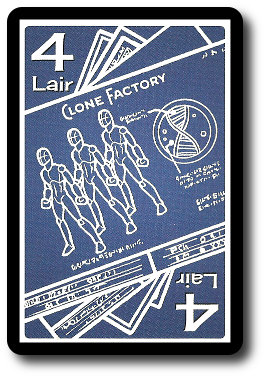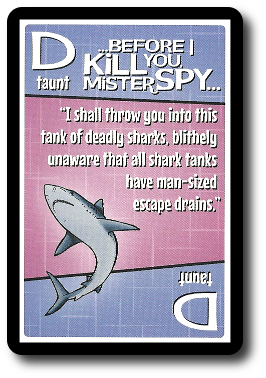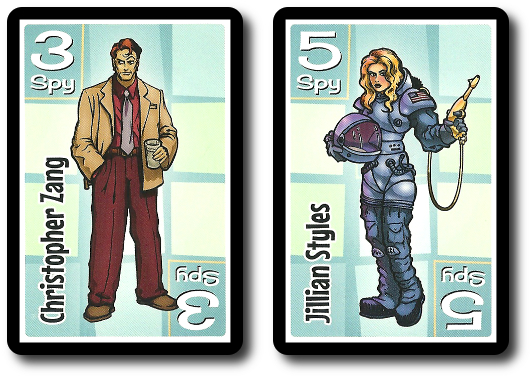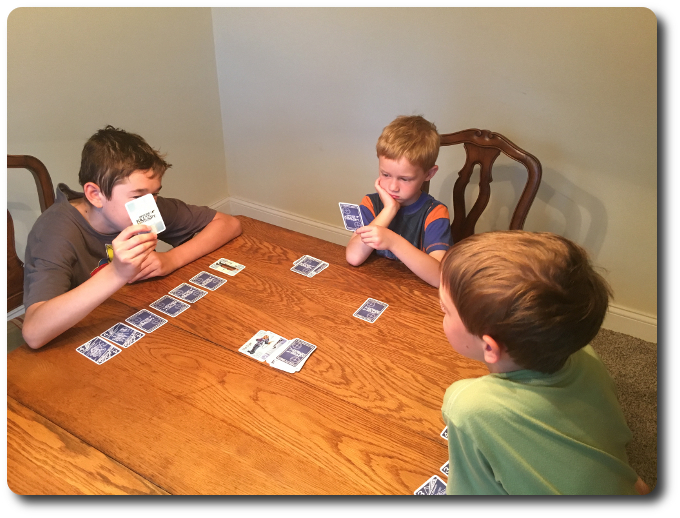
The Basics:
- For ages 6 and up (publisher suggests 12+)
- For 2 to 6 players
- Approximately 30 minutes to complete
Geek Skills:
- Counting & Math
- Logical & Critical Decision Making
- Risk vs. Reward
- Hand/Resource Management
- Bluffing and Misdirection
Learning Curve:
- Child – Easy
- Adult – Easy
Theme & Narrative:
- Lure or send spy agents to their doom
Endorsements:
- Gamer Geek rejected!
- Parent Geek approved!
- Child Geek approved!
Overview
There is a covert war taking place that’s invisible to everyone. Various spy agencies battle it out in the shadows in hopes of obtaining political control. However, very few know about you, the true puppet master. Occasionally a spy will have the misfortune of learning more than they should. Such curiosity cannot be tolerated, but it’s not all bad. Eliminating enemy agents can be fun.
Before I Kill You, Mister Spy, designed by James Ernest and published by Cheapass Games, is comprised of 15 Lair cards, 18 Taunt cards, and 22 Spy cards. The cards are as thick and as durable as your standard playing card. The artwork by Cheyenne Wright is clean and colorful, giving the spies notable physical characteristics that further strengthen the game’s theme.
Secret Set Up
To set up the game, shuffle all the cards together and deal a set number of cards to each player, face-down. The number dealt is based on the number of players.
Second, place the remaining deck of undealt cards face-down in the middle of the playing area. This is the draw deck for the duration of the game. Leave room for a discard pile.
That’s it for game set up. Determine who will be the first player and begin.
Spy Games
Before I Kill You, Mister Spy is played in turns with no set number of turns per game. A player’s turn always starts with them drawing the top-most card from the draw deck and adding it to their hand. They then must take one of the following actions. Based on the action taken, they may have one or more additional follow-up actions.
Play a Lair Card
The Lair cards represent the different facets of the player’s super secret evil agency. The number values on the Lair cards represents the lair’s operational importance to the overall agenda of the player. Any Lair card the player has can be placed in front of them for their action, but the player must decide if they want to place the Lair card face-up or face-down. If placed face-up, the player and the player’s opponents all know how important that Lair card is. However, the player can also choose to play their Lair card face-down, which hides it true value. By doing so, however, the Lair card’s value is set to “1”, regardless of the numbers shown on the card’s face.

A player can also play a Taunt card that has the same card back as a Lair card. Taunt cards can be played face-down to appear to be a Lair card, but are actually a death trap, as explained shortly.

All played Lair and Taunt cards masquerading as a Lair card are played in front of the player in a row. Only 1 card can be played on the player’s turn.
Steal a Lair Card
A player can send a Spy card in their hand to steal a Lair card currently owned by an opponent. These are referred to as “Double Agents”. Each Spy card has a number value that will be used to determine the player’s final score and also represents the spy’s abilities. If the player wants to steal a Lair card, they play their Spy card from their hand, placing it on top of their opponent’s Lair card.

- If the Spy card’s number value and the Lair card’s number value are equal, the player takes their opponent’s Lair card (claiming it as their own) and scores their “Double Agent” Spy card.
- If the Spy card’s number value is greater than the Lair card’s number, the player takes their opponent’s Lair card (claiming it as their own) and discards their “Double Agent” Spy card.
- If the Spy card’s number value is less than the Lair card’s number, the player gives their opponent their “Double Agent” Spy as a prisoner.
Lair cards that are face-down can also be a target, but attempting to steal such cards is risky. Face-up cards tell the player exactly what their “Double Agent” Spy card value needs to be in order to be successful. A face-down card reveals nothing other than a tantalizing prize to be won. If the player does decide to attempt to steal a face-down Lair card, the Lair card is revealed and placed face-up for the duration of the game. The players then compare the “Double Agent” Spy and Lair card values and take the next action as described above.
If the revealed Lair card is a Taunt card, the Double Agent has blundered into an inescapable deathtrap! The opponent scores the Spy card and the Taunt card is discarded.
Play a Spy Card
Spy cards can either be played to an opponent’s secret Lair cards or to the player’s secret Lair cards. Obviously, the player has more knowledge regarding what they have before them, so it’s a safer bet. However, a player may not have the right Lair card values to make it worthwhile, which will require them to make use of a Double Agent.
Regardless of how the player approaches using their Spy cards, a spy can only be captured or steal.
Stealing a Lair card with a Spy card has already been explained. Now let’s discuss the grizzly fate of captured spies. A spy is captured if the sum of all the Lair cards in play is greater than the Spy’s value. Then the player must decide to “retired” them or taunt them. If they “retire” the spy, they collect the Spy card and score it.
But what good is that? As an evil organization bent on world domination, you can’t help but gloat a bit. A Taunt card can be placed on top of the captured Spy card, doubling it’s score value. The game then pauses for a brief moment, allowing opponent’s to determine if they want to stop the player from earning more points. If an opponent has the matching Taunt card, they can play it now. This foils the player’s plans to the extreme. Both Taunt cards are discarded, as is the Spy card, which escapes during the player’s long-winded monologue.
If opponents do not attempt to foil the Taunt card, the player can either “retire” the Spy card, collecting both the Spy card and the Taunt card for points, or taunt the spy again! SO EVIL! Of course, the new Taunt card can be foiled, resulting in the same negative effects. This continues until either the player scores the now dead spy or the spy escapes.
Steal a Spy Card
While the spies in the game might be the best of the best of the best of the best (or perhaps even a bit better than that), they are exceedingly easy to spot. This is due, in part, to the player’s massive secret organization that runs everything from soft drinks to toilet paper. Yes, they are everywhere. If a player chooses, they can steal a Spy card (which has a different card back than the Taunt and Lair cards), taking it from the top of the draw deck or an opponent’s hand. The Spy card is then transferred to the player’s hand.
Once stolen, the Spy card can then be used to steal a Lair card or drop kicked into the player’s lair for systematic torture and a light lunch. The only rule regarding this action is that a player cannot attempt to steal a Lair card from the same opponent they just stole a Spy card from. This is seen as rude by the underground shadow agencies that rule the world and a small section of the outer galaxy.
Spied Out
The game ends when the draw deck is exhausted (wherein the game finishes after the player who drew the last card completes their turn) or a player has collected 33 or more points at the end of their turn. If the deck runs out first, the player with the highest points wins.
To learn more about Before I Kill You, Mister Spy, visit the game’s web page.
Final Word
The Child Geeks had a lot of fun drawing in spies and attacking their opponent’s lairs. Lack of defensive capabilities was a problem at first, but since no one had the ability to protect their lairs, the issue quickly became moot. The most surprising turn in the game was how aggressive the Child Geeks played Taunt cards for both their points and as lair landmines. According to one Child Geek, “You cannot attack another player directly, but you can do enough to cause them problems.” It was “just enough” to keep the Child Geeks guessing and maintain a certain level of caution throughout. This subtle, but obvious, risk versus reward was not lost on any Child Geek. As one Child Geek put it, “This game is about taking advantage of what you know and taking some risks, but you don’t have to take any risks if you don’t want to.” Come risk, reward, or total failure, the Child Geeks all voted to approve the game.

My oldest son tries to read his younger brother’s face as he contemplates where to send his spy (who died)
The Parent Geeks found the soft morbid undertone of the game to be strangely entertaining. According to one Parent Geek, “I’m sending spies to their death again and again and again. I love it.” The game doesn’t focus on or really make much effort to suggest exactly what happens to any of the spies, but that didn’t stop the Parent Geeks from coming up with long-winded descriptions of how certain spies met their untimely end. Another Parent Geek said, “I think this is a great game to play with others when you don’t have much time or when you want to play a smaller game between other games.” In other words, a filler. True, this micro game could easily fit between the cracks found in schedules and plays just as fast as the players want it to. When all the games were over, the Parent Geeks found Before I Kill You, Mister Spy to be fun, fast, and perfect for their family and friends.
The Gamer Geeks liked the game’s theme, but not the game play. According to one Gamer Geek, “I might be able to suggest this game as a filler, but there is so much to it that is just random card plays. A great deal of the game is hidden information, leading players to guess a lot.” Another Gamer Geek said, “I can see the game’s hidden agenda here. It wants players to risk, hide, and lure, but the impact to the overall game play feels small.” As a micro game, the Gamer Geeks felt like Before I Kill You, Mister Spy did a good job of entertaining, but it was not a game they wanted to play more than once. As one Gamer Geek put it, “A fun game to play once, then you don’t need to play it again.” As such, the Gamer Geeks decided to reject Before I Kill You, Mister Spy.
Micro games can be hard to review objectively. There is a lot going on in the game, but the overall depth of the game keeps most of it from feeling important. There is a great deal of bluffing, but everyone can bluff by simply keeping their Lair cards face down. Pretty soon, everyone is doing that, which doesn’t result in bluffing but lack of any information at all. Guessing is required, but not memory, as Lair cards are revealed and stay revealed once explored. Players can even attack their own Lairs, which makes attacking opponent’s lairs only a necessity if the player doesn’t have the right card values. The end result is a game that is easy to play, but not one that feels overly intriguing.
But let’s take another look at it. Before I Kill You, Mister Spy makes no apologies for what it is and how it goes about its business. Players are given a lot of power in this game and they can manipulate a lot of the cards, but never to a point where they completely control the table. In fact, the more power and influence the player thinks they have, the number of opponents who interact with them will be reduced. This is where turning Lair cards face-down and face-up comes into play and is, in my opinion, the most important part of the game. If a player advertises what they have, they are clearly making an effort to lure in opponents, but they also give themselves a backdoor to easy points. On the other hand, if they keep their Lair cards face-down, they might tempt an opponent, but have no real control over what Spy card is played. In addition, they greatly reduce what they can do with their own Lair cards.
Before I Kill You, Mister Spy is all about finding a happy medium in as short amount of time as possible. There is no formula to follow, as what the player should focus on is directly influenced by what their opponents do. I’ve seen games where everyone played their Lair cards face-down and others where they were played face-up. In both cases, the game play was the same, but the decisions to be made were exceedingly different.
The Child Geeks and the Parent Geeks liked this game, and so did I. If I were to guess, I think the Gamer Geeks disliked the game more out of principle than actual game faults. The rules are tight, the game play is smooth, and there is depth enough to explore and find different ways to win. Before I Kill You, Mister Spy is a well-rounded micro game that will challenge and entertain without requiring a lot of your time or anymore than 50% of your brain, which is perfect for mixed skill groups or late night gaming. Do try it if the opportunity presents itself.
This game was given to Father Geek as a review copy. Father Geek was not paid, bribed, wined, dined, or threatened in vain hopes of influencing this review. Such is the statuesque and legendary integrity of Father Geek.



